年产3.6万吨乙烯精馏浮阀塔设计(含CAD零件装配图)

年产3.6万吨乙烯精馏浮阀塔设计(含CAD零件装配图)(设计说明书10000字,CAD图纸4张)
摘要
随着社会的发展与进步,我国乙烯的市场需求量急剧增加,乙烯进口量逐年增加,国内产品市场占有率还不到百分之五十。乙烯工业是石油化工产业的龙头,其发展水平早已成为衡量一个国家综合经济实力的重要标志之一,在石油化工产业乃至国民经济发展中占有极其重要的地位。
塔设备在化工、石油、医药、食品及环境保护等工业部门中广泛使用的重要生产设备,是一种十分重要的单元操作设备。塔设备的作用在于提供气、液两相以充分接触的机会,使质、热两种传递过程能够迅速有效地进行,从而达到相际间进行传质及传热的目的;还可以使接触后的气、液两相能够及时分开,互不夹带。塔设备主要应用在石油化工行业,其种类颇多,按操作压力分有加压塔,常压塔及减压塔;按内件结构分有填料塔、板式塔;还有按单元操作分有精馏塔,吸收塔,介吸塔,萃取塔,反应塔,干燥塔等。
本次设计的是年产3.6万吨乙烯精馏浮阀塔。浮阀塔是20世纪50年代前后开发和应用的,并在石油、化工等工业部门代替了传统使用的泡罩塔,成为当今应用最广泛的塔型之一,并因具有优异的综合性能,在设计和选用塔型时常是被首选的板式塔。本次设计主要包括三大方面的内容:一是工艺计算;二是强度及稳定性的计算;三是专题部分的补充。 [资料来源:Doc163.com]
第一部分主要进行了物料衡算,塔内物件尺寸的确定,塔温、塔板数的计算以及各种管径的确定,附属设备的选择等等。
第二部分主要是在强度及稳定性计算中计算出塔器的各部分质量,从而对塔的三个危险截面进行校核,主要是质量载荷,风载荷与地震载荷的计算,另外还要进行补强的计算。
最后即是专题部分:吊柱的选用与校核。
关键词: 板式塔; 精馏设备; 填料塔
Abstract
With the social development and progress, China's ethylene market demand for a sharp increase in the amount of ethylene imports increased year by year, the domestic market share of less than 50 percent. Ethylene is the leading petrochemical industry, and its level of development has become the measure of a country's comprehensive economic strength, an important sign, occupies an extremely important position in the petrochemical industry and the national economy.
Important tower production equipment in the chemical, petroleum, pharmaceutical, food and environmental protection and other industrial sectors are widely used, it is a very important unit operation equipment. You can also post the contact; the role of the tower equipment to provide gas and liquid phases opportunity to full contact, so that quality, two kinds of heat transfer process can be carried out quickly and efficiently, so as to achieve the purpose of phase interpersonal conduct mass transfer and heat transfer the gas and liquid phases can be separated in time, and do not entrainment. Tower equipment mainly used in the petrochemical industry, and its many types, according to the operating pressure divided pressurized tower, atmospheric tower and vacuum tower; internals structure divided by the packed tower, plate tower; there are divided by unit operation fractionator, absorber, dielectric absorption towers, extraction column, reaction tower, drying tower. [资料来源:www.doc163.com]
The design is an annual output of 36,000 tons of ethylene distillation tower float valve. Float valves before and after the 1950s, the development and application of, and in the petroleum, chemical and other industrial sectors instead of the traditional use of the bubble column, becoming the most widely used type of one of the towers, and because of excellent overall performance, in the design and selection of tower type it is often preferred plate column. The design mainly includes three aspects: First, the calculation process; the second is to calculate the strength and stability; third is to complement the thematic segment.
The first part was the material balance, the tower object to determine the size, column temperature, the calculated number of plates of various diameters and determine the choice of ancillary equipment and so on.
The second part is the quality of each part of the tower is calculated in the calculation of strength and stability, thus dangerous section of the three towers to be checked, mainly the mass load, calculate wind loads and seismic loads, but also for additional calculated reinforcement. [资料来源:Doc163.com]
That last part is thematic: davit Selection and Verification
Key words: Tray Tower; Distilling Equipment; Packed towe
[资料来源:http://doc163.com]




目 录
前言 1
第一章工艺计算 3
1.1 物料衡算 3
1.1.1 塔顶产品量 3
1.1.2 塔釜、塔顶流量及组成 3
1.2 确定塔温 4
1.2.1 塔釜温度的确定 4
1.2.2 塔顶温度的确定 5
1.2.3 进料温度 6
1.3 塔板数的计算 6
1.3.1 确定最小回流比 6
1.3.2 确定最小理论板数 7
1.3.3 确定理论板数 7
1.3.4 实际塔板数 8
1.3.5 确定进料板位置 8
1.4 塔径计算 9
1.4.1 精馏段塔径 9
1.4.2 提馏段塔径 12
1.5 塔内物件的工艺尺寸 13
1.5.1 溢流程数的选择 13
1.6 流体力学验算 15
1.6.1 气体流过塔板的压降 15
1.6.2 液泛校核 15
1.6.3 雾沫夹夹带情况 16
1.7 安全操作范围和操作线 16
1.7.1 精馏段 16
1.7.2 提馏段 17
1.8 附属设备的选择 19
1.8.1 全凝器的选择 19
1.8.2 再沸器的选择 19
1.8.3 回流泵的选择 19
1.9 管径设计 20
1.9.1 塔顶蒸汽管 20
1.9.2 回流管管径 20 [资料来源:www.doc163.com]
1.9.3 进料管管径 20
1.9.4 塔釜出料管 20
1.9.5 进再沸器管 21
1.9.6 再沸器蒸汽入塔器 21
第二章强度及稳定性计算 22
2.1 圆筒和封头的厚度和强度计算 22
2.2 载荷的计算 22
2.2.1 质量载荷的计算 22
2.2.2 塔的自振周期 24
2.2.3 地震载荷及地震弯矩的计算 24
2.2.4 风载荷和风弯矩计算 26
2.2.5 最大弯矩 28
2.3 应力校核 28
2.3.1 圆筒应力校核 28
2.3.2 裙座壳轴向应力校核 30
2.4 基础环结构设计及校核 31
2.4.1 基础环 31
2.4.2 地脚螺栓计算 32
2.4.3 肋板计算 32
2.4.4盖板计算 33
2.5 补强计算 34
2.5.1 塔顶蒸汽出孔 34
2.5.2 人孔的补强计算 35
2.5.3 进料管接管补强 36
第三章吊柱的强度计算 38
3.1 设计载荷 38
3.2 曲杆部分的校核 38
3.3 柱的校核 39
总结 41
参考文献 42
致谢 43
